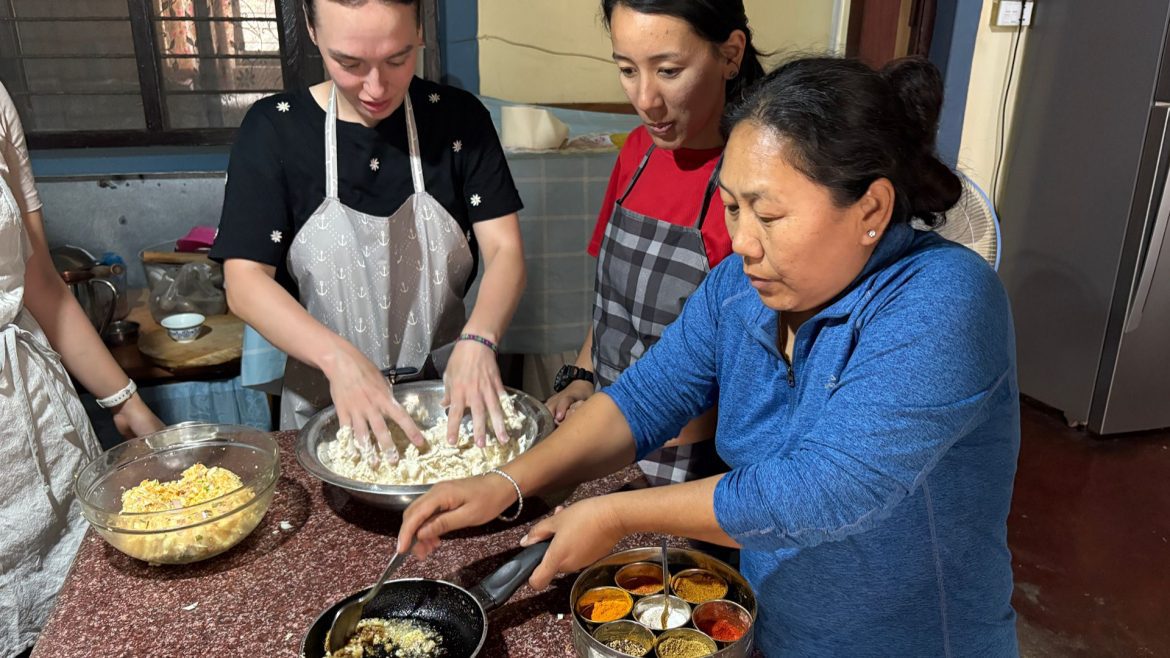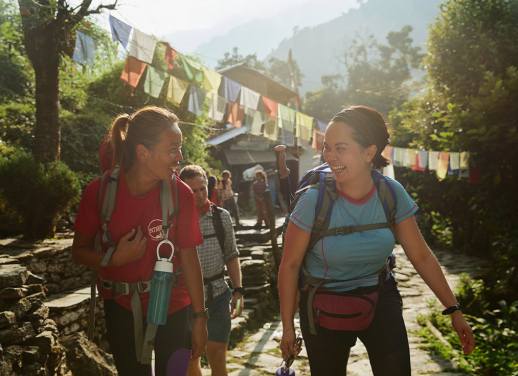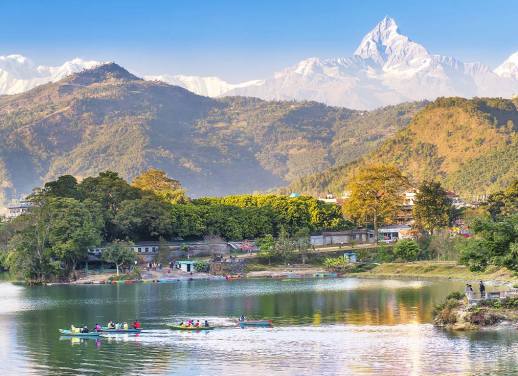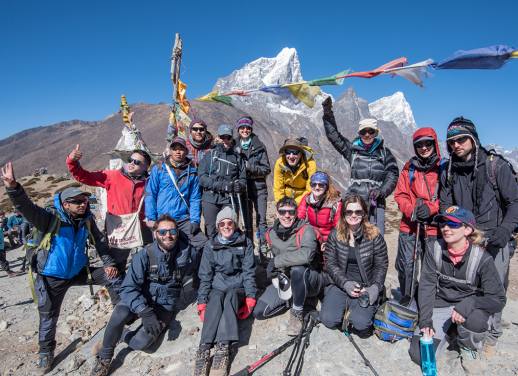On a Women’s Expedition in Nepal with Intrepid, writer Cliona Elliott joins a cooking class with refugee-turned-chef Dolma Thundup to learn the art of making dumplings with a side serving of resilience.
‘This is Dolma. You can call her Aunty,’ says Keshu, our Intrepid group leader, as we sit around a garden table beneath hibiscus and papaya trees. Prayer flags flutter along the roof. A neighbour sweeps their porch. Chickens peck across the grass. For a moment, I almost forget we’re just minutes from the city of Pokhara, Nepal’s busy gateway to the Annapurna Circuit.
‘Dhanyabaad (thank you),’ we say, as Dolma hands out lemonade and khapse (deep-fried pastry twists). But before we get too comfy, she leads us through a white-curtained door into the kitchen. ‘Today we make momos,’ she announces, pulling out chopping boards and utensils.
The room fills with chatter, clanging knives and the smell of fresh garlic and ginger, as shredded cabbage and ribbons of carrot pile up on the worktop.
Read more: One woman’s remarkable route to climbing Everest



Momos on the move
In many ways, Dolma’s story is folded into the fine flour that makes up momos themselves – the two stories impossible to sift. Like the half-moon-shaped dumpling, Dolma is Tibetan. Although she was born in Nepal, her family migrated here following the Chinese invasion of Tibet in 1950, which led to a decade of repression that culminated in the Tibetan Uprising of 1959.
A brutal crackdown from Chinese authorities ensued, killing and injuring thousands, and sparking fears for the safety of the Dalai Lama, Tibet’s spiritual leader. He escaped to Dharamsala in northern India where he set up the Tibetan Government-in-exile, and thousands of asylum seekers followed him to safer refuges around the world. By 1960, over 80,000 Tibetans – including Dolma’s parents – had fled to Nepal, India and Bhutan.
With them, they brought their cherished recipes from home. And while momos first travelled to Nepal as far back as the 14th century – introduced by itinerant Newari merchants – there’s no doubt that the movement of Tibetan refugees in the 20th century helped spread the appeal of this delicious staple throughout South Asia and beyond.
Read more: Meet the women changing the narrative in Nepal



Aunty knows best
Dolma floats around the kitchen, chatting away while keeping a watchful eye on proceedings. ‘No, no, not like that,’ she chides Sue, a recently retired science teacher from Boston, USA, who’s wrist-deep in a bowl of chicken mince.
A few of us exchange giddy glances, our lips lightly pursed like school kids trying not to laugh in class. Dolma runs a tight ship, with the strict-yet-loving approach that only someone called ‘Aunty’ can have.
Next comes the seasoning. The key to a tasty momo is a spice mix called momo masala – a fragrant blend including cumin, mustard seed, fenugreek, coriander seed and chilli. After sizzling ginger and garlic in a splash of oil, she adds a generous sprinkle of salt and the masala to form a paste, and then folds it into the momo mixture.
With the fillings ready, it’s time to prepare the dough. Dolma trickles water into a pile of flour before asking Zuzana, my trip roommate from London, to take over. She soon gets into the swing of it, head rocking rhythmically back and forth as she kneads. It’s strangely therapeutic to watch – and it’s in this moment of meditative calm, all gathered around the kitchen bench, that Dolma begins to share her story.



Life as a Tibetan refugee
‘My parents fled Tibet in 1959 and came to Pokhara in 1964,’ she begins. ‘They travelled across the mountains and stayed with a family near the [western] Dolpo/Mustang border. They didn’t have any money, but the Nepali people offered food – flour, rice, things like that – in exchange for dancing, singing or working in the fields. Around 700 Tibetans came to Pokhara, but now there are only 400 in this settlement. I was born and raised here.’
Dolma is the eldest of three sisters, both of whom are now married. Her father lived with her until he passed away several years ago.
‘We all [used to] live together before, but now I live alone so I need to make money. My sisters helped me to build my home.’
Sue asks if she could move somewhere else in Nepal, if she wanted to. ‘It’s not possible unless you marry. But these days, many young people get married and settle in other places.’
Refugees in Nepal – including second- and third-generation Tibetans – generally can’t claim citizenship, own property or access government services and higher education. The Tibetan Government-in-exile can provide a Green Book that acts as an identity document, but it’s not recognised for travel. Dolma is essentially stateless.
‘It’s hard to get a job as I don’t have much education, but Intrepid is supporting me through each group like you. Now I’m making money,’ she says.
Before starting the cooking classes, Dolma sold jewellery and souvenirs at a street stall. She began working with Intrepid in 2019 and is one of the many female-owned businesses Intrepid partners with on the Nepal Women’s Expedition. The trip is part of a series of female-led Women’s Expeditions launched in 2018, which aim to help break down barriers of traditional, male-dominated tourism and allow travellers to connect with and learn about the lives of local women.
We tell her we’re very happy to meet her. ‘Me too, me too,’ she replies. ‘When I talk about this, I get emotional.’ She isn’t the only one blinking back tears.
As well as momos, Dolma teaches groups how to make thukpa (Tibetan noodle soup) and dal bhat (Nepal’s national dish of lentils and rice). But her first love is momos. ‘I learned how to make momos at home with my mama,’ Dolma says. ‘We cooked them for family gatherings, festivals and special occasions. When I was a child, we were very happy when we made momos. We ate many. Sometimes 10 or 12 big ones.’ At roughly the size of a tennis ball, this is an impressive feat.
She also tells me she loves meeting people from all over the world. ‘It makes me happy. It’s a new experience every time. We share stories, sometimes funny stories. I feel very grateful. I never thought I’d teach momo classes.’
Despite the reflective mood, Dolma quickly reminds us that she hasn’t for one moment taken her eye off our efforts. ‘Ah, now it’s good!’ she says, poking her index finger into the mound of dough Zuzana’s being tirelessly kneading.
Read more: The female leader challenging gender norms in Nepal



Pinch and roll
Assembling the momos is the final step. Half the group rolls and cuts the dough into discs; the rest stuff and seal them into neat, appetising shapes, which it turns out is quite tricky.
‘No, too big! Ooh, la la,’ says Dolma.
‘Not too much meat!’ (This was my problem.)
Dolma demonstrates how to do it again, our eyes glued to her hands as she delicately closes it within seconds. ‘Pinch, roll. Pinch, roll. You see? You need to say it from your mouth to do it.’ And she’s right. This chant seems to help us turn a corner. ‘That’s better now. Good.’
In fact, Ashling from Perth, Australia, is that good at sealing them, Dolma informs her she’s going to get a good husband. I place my slightly mangled momo on my palm in front of her and ask whether I share a similar fate – though I think I already know the answer.
She grins. ‘Ok, mayyybe husband will come.’
It takes a little while, but we end up with about 50 momos – enough to fill two large steaming baskets. Dolma sets the timer and fixes up some achar (pickle) while they cook. Achar tastes different wherever you go in Nepal, but Dolma makes hers by simmering tomato, onion, garlic, chilli, cumin and turmeric into a sauce, letting it cool, then blitzing it with hemp seeds. Once it’s nice and creamy, she tosses in a handful of chopped coriander and it’s good to go.
After 12 hot and hungry minutes, we finally hear that much anticipated ‘DING!’



Made with Tibetan love
With everyone sitting around the table, we pile our plates with momos, lashings of achar and chunks of cucumber. The achar has a perfect balance of tanginess and heat, the momos are steamed to perfection and the cucumber adds a cool, refreshing crunch.
The chatter fades, save for the occasional ‘yum’, and most of us go back for seconds.
‘They’re made with love,’ I hear someone say at the other end of the table. ‘Tibetan love,’ adds Keshu.
Dolma smiles. ‘Yes, made with Tibetan love.’
Another alarm suddenly rings out.
‘That’s not more momos, is it?’ Kristen from Adelaide, Australia, asks, eyes wide with concern. ‘No,’ I laugh. ‘It’s just her phone ringing.’
‘Oh, thank god,’ she exhales. I’m relieved too. Even though I’m full to the brim, if Dolma walks out with more, I won’t be able to say no.
I ate my fair share of momos in Nepal, but none came close to Dolma’s. It wasn’t just meat and vegetables folded into that dough. It was the resilience of the Tibetan people, her passion for sharing her culture and the strength of a woman carving a path forward despite the obstacles in her way.
Dolma shared that if all goes well, she’d like to open a small cafe one day. And for the sake of everyone visiting Pokhara, I really hope she does, so that more people can taste Dolma’s momos – made with Tibetan love.
Master the art of making momos with Dolma on Intrepid’s Nepal: Women’s Expedition.




